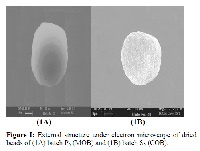Formulation and In-vitro evaluation of pH sensitive oil entrapped buoyant beads of amoxicillin
Keywords:
Amoxicillin (Am), Calcium pectinate bead, Residential time, pH Sensitive, Ethyl cellulose (EC)Abstract
A gastro retentive pH sensitive system has been a frontier approach to release the drug in controlled manner in stomach and duodenum. The aim of the study is to develop reliable formulation of amoxicillin which will release the drug in controlled way at specific site with acidic pH stimulus present in the gastric region. In the present investigation pectin based oil entrapped micro gel beads were prepared by ionic gelation technique using castor oil and mineral oil. The developed beads were evaluated in term of diameter, surface morphology, floating lag time, encapsulation efficiency, in vitro drug release. Prepared microbeads were regular and spherical in shape. The formulation exhibited sustained release profile and was best fitted in the Peppas model with n < 0.45. Subsequent coating of microbeads exhibited zero-order sustained pattern of amoxicillin release up to 8 hrs. The Results provides evidence that optimized gel bead may be used to incorporate antibiotics like amoxicillin and may be effective when administered locally in the stomach to cure microbial infection.
References
Rouge N, Buri P, Doelker E. Morphology and
buoyancy of oil-entrapped calcium pectinate
gel beads. Int J Pharm 1996; 136: 117–139.
Ichikawa M, Watanabe S, Miyake Y. A new
multiple unit oral floating dosage system:
Preparation and in vitro evaluation of floating
and sustained-release kinetics. J Pharm Sci 1991;
: 1062-1066.
Choi BY, Park HJ, Hwang SJ, Park JB.
Preparation of alginate beads for floating drug
delivery system: effects of CO2 gas-forming
agents. Int J Pharm 2002; 239: 81-91.
Niagara N, Akiyama Y, Nako M, Tada M,
Kitano M. Mucoadhesive Microspheres
Containing Amoxicillin for Clearance of
Helicobacter pylori . Antimicrob Agent
Chemother 1998; 42: 2492–2494.
Choi BY, Park HJ, Hwang SJ, Park JB.
Preparation of alginate beads for floating drug
delivery system: effects of CO2 gas-forming
agents. Int J Pharm 2002; 239: 81-91.
Niagara N, Akiyama Y, Nako M, Tada M,
Kitano M. Mucoadhesive Microspheres
Containing Amoxicillin for Clearance of
Helicobacter pylori . Antimicrob Agent
Chemother1998; 42: 2492–2494.
Cooreman MP, Krausgrill P, Hengels KJ. Local
gastric and serum amoxicillin concentrations
after different oral application forms. Antimicrob
Agents Chemother 1993; 37: 1506–150.
Narkar M, Praveen Sher P, Paw A. StomachSpecific Controlled Release Gellan Beads of
Acid-Soluble Drug Prepared by Ionotropic
Gelation Method. AAPS PharmSciTech 2010;
: 267-277.
Babu RJ, Sathigari S, Kumar MT, Pandit JK .
Formulation of controlled release gellan gum
macro beads of amoxicillin. Curr Drug Deliv
; 7:36-43.
Sriamornsak P, Thirawong N, Puttipipatkhachorn
S. Morphology and Buoyancy of Oil-entrapped
Calcium Pectinate Gel Beads. AAPS
PharmSciTech 2004; 6 : 24-31.
Yeole PG, Khan S, Patel VF. Floating drug
delivery system: Need and development. Indi
J Pharm Sci 2005 ; 67 : 265–272.
Westphal JF, Deslandes A, Brogard JM, Carbon
C. J Antimicrob Chemother 1991; 27 : 647-654.
Devani MB, Patel IT, Patel TM.
Spectrophotometric determination of amoxicillin
and its dosage forms. J Pharm Biomed Anal
; 10: 355-358.
Rolin C, Whistler RL, Bemiller JN. Industrial
Gums: Polysaccharides and their derivatives.
New York, Academic Press 1993 ; 257-293.
Schols HA, Voragen AG. Complex pectin:
structure elucidation using enzymes. In: Visser J,
Voragen AGJ, eds. Progress in Biotechnology:
Pectin and Pectinases. Amsterdam, the
Netherlands, Elsevier 1996; 3-19.
Leroux J, Langendorff V, Schick G, Vaishnav V.
Emulsion stabilizing properties of pectin. Food
Hydrocolloids 2003; 17: 455-462.
Cooreman MP, Krausgrill P, Hengels KJ. Local
gastric and serum amoxicillin concentrations
after different oral application forms. Antimicrob
Agents Chemotherm 1998; 37: 1506–1509.
Tanigake A , Miyanaga Y , Nnakamura T , TsujiI
E , Matsuyama K , Kuntitomo M., Uchida T.
The Bitterness Intensity of Clarithromycin
Evaluated by a Taste Sensor. Chem Pharm Bull
; 51 : 1241—1245.
Erah PO, Goddard AF, Barrett DA, Shaw PN,
Spiller RC. The stability of amoxicillin,
clarithromycin and metronidazole in gastric
juice: relevance to the treatment of Helicobacter
pylori infection. J Antimicrob Chemother 1997;
:5–12.
Zheng J , Liu C, Bio D, Zhao Y, Ma X.
Preparation and evaluation of floatingbioadhesive microparticles containing
clarithromycin for the eradication of
Helicobacter pylori. J Appli Poly Sci2006;
:2226-2232.
Streubel A, Siepmann J, Bodmeier R. Floating
microparticles based on low density foam
powder. Int J Pharm 2002; 241:279–292.
Wagner JG. Interpretation of percent dissolvedtime plots derived from in vitro testing of
conventional tablets and capsules. J Pharm Sci
; 58 : 1253–1257.
Higuchi T. Mechanism of sustained-action
medication: theoretical analysis of rate of release
of solid drug dispersed in solid matrices. J Pharm
Sci 1963; 52:1145–1149.
Korsmeyer RW, Gurny R, Peppas N.
Mechanisms of solute release from porous
hydrophilic polymers. Int J Pharm 1983 ; 24 :
–35 .DARU 18(1) 9-16 (2010)





